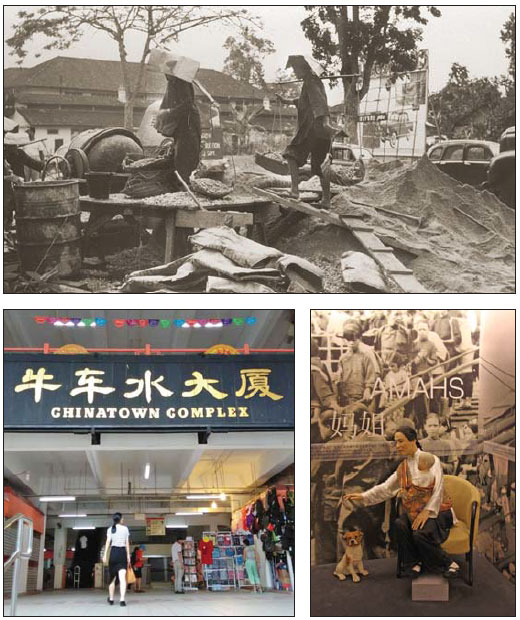Paying tribute to unsung heroines who built a city
Updated: 2016-09-16 07:11
By Zhao Xu(China Daily Europe)
|
|||||||||
Chinese women who left the mainland faced untold suffering
The 19th and early 20th century Chinese immigrants to Singapore deserve more than a few books for their remarkable tales of survival. Among them, there are two groups whose experiences, although little known outside of Singapore, best embody the courage and grit of their generation.
One group is known as mahjie in Cantonese, the dialect of the Chinese province of Guangdong.
|
Clockwise from top: Samsui women, from the Chinese province of Guangdong, worked at the construction sites of Singapore and distinguished themselves through the red scarves they wore. Mahjie, meaning mother-sister, were domestic helpers from China. Chinatown in Singapore. Tan Wei Ann / For China Daily |
The word means "mother-sister".
"It is mother because these women from Shunde, in Guangdong, were mostly domestic servants for rich local families, and in this role they helped raise the children in the family; and sister because they, before leaving for Singapore, took a vow of celibacy, often as a means to escape arranged marriages," says Sophie Soon, from the Chinese Heritage Center in Singapore.
In a sense, it was their spinsterhood that had brought them to this new land, according to the museum guide.
After taking the vow, these women were regarded as independent and therefore could no longer live at home with their families.
Left to fend for themselves, many of them worked in the silk industry for which Shunde was famous.
But when the industry began to decline in the 1930s, just before the Japanese invasion of China, many of them left for Southeast Asia, including Singapore.
They were joined there by the Samsui women - forming the larger picture of female migration from China.
Known also as hongtoujin, Mandarin for "red headscarves", these women from the Samsui area of Guangdong worked as laborers in the construction industry, an industry that traditionally was almost exclusively the preserve of men.
While the mahjie donned white tops and black trousers, these Samsui women had their own unofficial uniform - red scarves and dark-blue or black outfits.
Chu Kin Fong, a local tour guide, says the color red served a purpose.
"The color red was to alert people and thus reduce the chances of accidents at the workplace," she says. "And, apart from sheltering them from the scorching sun in the tropical country, the starched hat could also be used to store cigarettes, matches and money.
"Coming to Singapore - then Malaya - in the 1920s and 1930s and working there until around the 1970s, these women, both the mahjie and the Samsui women, helped shape the country in a profound way.
"For those who know their stories, these women are an integral part of the contemporary history of Singapore," says Chu, pointing to the stone sculptures of Samsui women erected in front of the Singapore City Gallery on No 45 Maxwell Road, where one can get an overview of how the city-state evolved and reinvented itself over the past 100 years.
The gallery is located on the southeastern end of Chinatown, where early Chinese migrants used to gather.
Without relatives in Singapore, these two groups of women turned to their own small but closely knit communities for solace.
Members of the same group often jointly rented rooms in Chinatown as living quarters.
The Samsui women, although not bound by vows of celibacy, were in many cases forced into spinsterhood due to a lack of suitable men to marry.
With their families always uppermost in their minds, these women sent home every penny they could save. However, one of the few things they spent their money on was on hiring professional letter writers to communicate with their loved ones back in China.
According to Chu, both groups of women passed into history as Singapore began its journey to becoming the rich, modern and super-clean city-state that people know today.
By the 1970s, many mahjie had gone into retirement, replaced by domestic helpers from neighboring countries such as the Philippines.
The jobs for the Samsui women lasted a little while longer. Some of them, who were already in their 60s and 70s then, continued to toil at construction sites right up to the 1980s, when their jobs were taken over by machines.
"The stories of these women were lost before they were unearthed by a society that decided to say a belated thank you to them," says Chu.
"There are now organizations that help to pay for these women to visit their hometowns in China, sometimes for the first time since their arrived in Singapore and probably the only time before they die."
While the Samsui women mostly lived in rental flats in their final years, most mah jie lived with the families they had served.
Reflecting on the role the mahjie played in the lives of the Singaporeans, Soon says: "The way that people used to refer to them says all: They were mothers first and foremost."
zhaoxu@chinadaily.com.cn
(China Daily European Weekly 09/16/2016 page16)
Today's Top News
UK gives Hinkley Point nuclear power green light
Hillary Clinton remains healthy: doctor
UK confirms Hinkley project with 'new agreement'
Despite big deals, data shows less M&As after Brexit
New plan for grammar schools welcomed by Chinese
Moscow denies involvement in hacker attacks on WADA
EU should stay strong, stable and united: Tusk
Cameron to quit as MP; by-election triggered
Hot Topics
Lunar probe , China growth forecasts, Emission rules get tougher, China seen through 'colored lens', International board,
Editor's Picks

|

|

|

|

|

|








